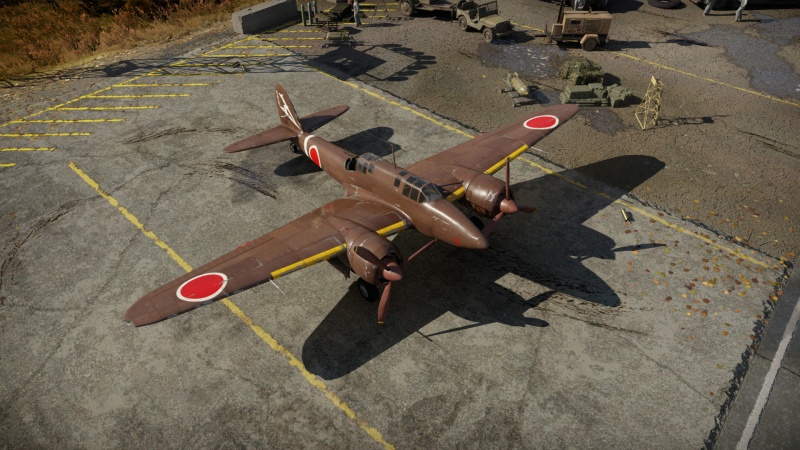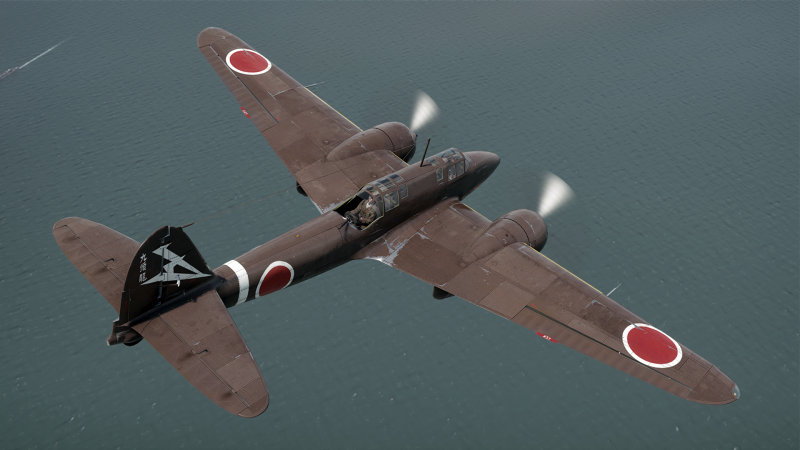Ki-45 hei
| This page is about the Japanese twin-engine fighter Ki-45 hei. For other versions, see Ki-45 (Family). |
Contents
Description
The Ki-45 hei Toryu was the successor of the Ki-45 "otsu/乙". It featured a revised armament, mainly designed to engage light naval target. This armament consisted of one 37mm Ho-203 automatic cannon on the nose while retaining its 7.92mm MG on the back as a defensive armament. Its armament only allowed the aircraft to engage small targets like patrol boats, since it lacked racks for suspended armament like bombs or torpedoes. Further upgrades where conducted in the form of the Ki-45 "tei/丁" and the Ki-45 II later renamed to Ki-96.
It was introduced in Update 1.31. Being a classed as a heavy fighter, the Ki-45 isn't the best in the manoeuvrability category. However, for a heavy fighter, it manoeuvres very well. It is even capable of out-turning aircraft such as the P-47D-25. Unlike heavy fighters of other nations, the Ki-45 series does not feature aircraft with large amounts of heavy weaponry. This is a major downside, considering how heavy fighters traditionally give up manoeuvrability and speed for armament. Instead, the Ki-45s utilize more of an equilibrium between manoeuvrability, speed, and armament. These are what makes the Ki-45 both a capable dog-fighter, and bomber hunter.
General info
Flight performance
| Characteristics | Max Speed (km/h at 6,300 m) |
Max altitude (metres) |
Turn time (seconds) |
Rate of climb (metres/second) |
Take-off run (metres) | |||
|---|---|---|---|---|---|---|---|---|
| AB | RB | AB | RB | AB | RB | |||
| Stock | 551 | 533 | 24.9 | 25.5 | 16.4 | 16.4 | 520 | |
| Upgraded | 593 | 570 | 23.2 | 24.0 | 23.1 | 19.5 | ||
Details
| Features | ||||
|---|---|---|---|---|
| Combat flaps | Take-off flaps | Landing flaps | Air brakes | Arrestor gear |
| ✓ | ✓ | ✓ | X | X |
| Limits | ||||||
|---|---|---|---|---|---|---|
| Wings (km/h) | Gear (km/h) | Flaps (km/h) | Max Static G | |||
| Combat | Take-off | Landing | + | - | ||
| 450 | 444 | 308 | ~11 | ~7 | ||
| Optimal velocities (km/h) | |||
|---|---|---|---|
| Ailerons | Rudder | Elevators | Radiator |
| < 360 | < 320 | < 450 | > 330 |
Survivability and armour
- 16 mm Steel plates behind the pilot
Modifications and economy
- Instead of focusing on armament like other heavy fighters, the Ki-45 is more balanced between armament and flight performance.
- While the default ammunition belts for both weapons on the Ki-45 ko are workable, it can help to upgrade.
- Unlocking the flight performance modules will help drastically in dogfights and turn fights.
Armaments
Offensive armament
The Ki-45 hei is armed with:
- 1 x 37 mm Ho-203 cannon, nose-mounted (15 rpg)
- 1 x 20 mm Ho-3 cannon, belly-mounted (100 rpg)
Suspended armament
The Ki-45 hei can be outfitted with the following ordnance:
- Without load
- 2 x 50 kg Army Type 94 GPHE bombs (100 kg total)
- 2 x 100 kg Army Type 94 GPHE bombs (200 kg total)
- 2 x 250 kg Army Type 92 GPHE bombs (500 kg total)
Defensive armament
The Ki-45 hei is defended by:
- 1 x 7.92 mm Type 98 machine gun, dorsal turret (1,050 rpg)
Usage in battles
This variant of the Ki-45, the Ki-45 hei, features virtually the same armament as the Ki-45 otsu. Wielding one Ho-3 20 mm cannon and one Ho-203 37 mm cannon, the Ki-45 hei is the pinnacle of a multi-purpose aircraft. Its 37 mm cannon allows it to take down bombers with ease, and its single 20 mm cannon allows for some flexibility in the dog-fighting department. Although deadly, the 37 mm cannon only holds 15 rounds, so shot placement is crucial. The round itself also travels fairly slowly in the air, making it hard to hit fast moving enemy fighters. The 20 mm cannon is best used in an anti-fighter role. Unfortunately, the Ki-45's ground attack role is minimal due to the inability to equip armour piercing rounds for the 37 mm cannon. The Ki-45 hei is also unable to equip bombs.
The Ki-45 hei also retains its impressive turn rate from the Ki-45 tei. Although the aircraft itself is large and presents an "easy target" in many players' minds, the Ki-45 is rather nimble. Use this to your advantage when engaging enemy aircraft. Unfortunately, the Ki-45 is a heavy fighter, meaning its turn time is still not on par with other aircraft such as the F2A-3. In certain cases, the Ki-45 pilot may have to rely on his or her tail gunner to get the job done. The "otsu" version of the Ki-45 features a 7.92 mm Type 98 machine gun with 1050 rounds. Although lacklustre, with shot placement it is possible to destroy enemies on the aircraft's tail. Aim for the pilot or the engine, as those are generally the weakest points on most aircraft. If the tailing enemy is a bi-plane, aim for the wings since they are very fragile.
The Toryu is also rather fragile for a heavy fighter. Although it does feature two engines, the Ki-45 does not have very much armour protection. Only the back of the pilot's seat has armour, leaving both the gunner and engines unprotected. This can prove costly in a fight. If one does find him or herself tailed, call upon teammates for assistance.
- In simulator, the Ki-45 has a decent frontal view with large pieces of glass in front, on top and to the sides, ensuring great visibility. The gunsight has enough room under, allowing easy tracking and leading of targets. However the side views are terrible as the wings & engines block out most of the view downwards, and a thick frame blocks out the upper area, as a result the common way of circling above an area to spot something is extremely limited. Rear visibility is almost non existent with the entire tail obstructed by the headset.
Tactics
The Ki-45 hei's armament is much more suited for bomber hunting than its earlier machine gun armed variant. With a moderate ammunition pool, it is easily possible to destroy multiple enemies with this aircraft. It is recommended to use the 20 mm cannon only when the pilot is sure he or she will hit the enemy aircraft, as it only holds 100 shells. The 37 mm cannon does impressive damage but requires a high degree of accuracy and lead. Practising with this weapon will help greatly, especially when attacking fighters.
Manual Engine Control
| MEC elements | ||||||
|---|---|---|---|---|---|---|
| Mixer | Pitch | Radiator | Supercharger | Turbocharger | ||
| Oil | Water | Type | ||||
| Controllable | Controllable Not auto controlled |
Controllable Auto control available |
Controllable Auto control available |
Separate | Controllable 2 gears |
Not controllable |
Pros and cons
Pros:
- Powerful 37 mm cannon
- Good manoeuvrability and climb rate for a heavy fighter
- Acceptable top speed
- 16.5 mm of armour in pilot's seat and added armour in the nose around 37 mm gun
- Twin-engine design
Cons:
- Beat in turn fights by some aircraft
- Prone to fuel and engine fires
- Locks up at high speeds
- Mediocre roll rate, gets worse as speed increases
- Lack of protection around fuel tanks, engines, and gunner
- Pilot is exposed in head-ons
- Limited ammunition for all weapons
- Long cannon reload time
- Limited anti-fighter capabilities
History
Initially designed to be a bomber escort, the Ki-45 was first deployed in what is now China and Vietnam. It was found to be easily outclassed by P-40s piloted by the Flying Tigers. As a result, the Ki-45's role was changed to anti-shipping and ground attack, where it performed satisfactorily. Nonetheless, the Ki-45's greatest strength proved to be its bomber intercepting capabilities. Heavily armed with 37 mm cannon, the Toryu (Dragon Slayer) could destroy heavy bombers with ease. As the war progressed, the need for an interceptor to defend the Japanese mainland was ever present. Soon, the Ki-45 was deployed to counter B-29 Superfortress raids. Although its armament was clearly deadly enough, the Ki-45 suffered at high altitudes. Pilots soon resorted to ramming attacks against the Superfortresses. Special attack groups specifically designed for this purpose formed, but by late 1945 Imperial Japan's fate had been sealed. The Allies allocated the name "Nick" to the Ki-45.
| Archive of the in-game description | |
|---|---|
|
Kawasaki Ki-45 KAI Hei (Model C) Type 2 Toryu (Allied reporting name: Nick) twin-engine army fighter The Ki-45 KAI Hei variant, with modified on-board armament (when compared with the Ki-45 KAI Otsu), was specially created to attack sea targets. A 37 mm Ho-203 automatic cannon with 15 rounds was mounted in the nose fairing, which had its shape modified. A 20 mm Ho-3 cannon with 100 rounds was placed in the lower section of the fuselage. The 7.92 mm Type 98 machine gun with 1,050 rounds remained in the rear defensive turret. In all other respects, the airframe was like that of the Ki-45 KAI Otsu. The Ki-45 KAI Hei was extensively used in New Guinea, particularly against American torpedo boats. One of the Ki-45 KAI Hei fighters was thoroughly tested in 1945 by US Army Technical Intelligence experts. The test results report mentioned the very good takeoff characteristics of the aircraft. Other capabilities won praise too: for example, the American pilots were struck by the machine's horizontal manoeuvrability. Stall characteristics were satisfactory, and pilots could sense when speed loss caused by flow separation was imminent. Landing performance was found to be very good, as well. Observed drawbacks included the aircraft's low taxi controllability due to poor breaks and the free-pivoting tail wheel. In addition, the aircraft's high nose-up position obscured forward visibility, so there was no choice but to taxi in a zigzag pattern. In addition to that, the report mentioned significant noise and vibration levels in the cockpit at all speeds, unsatisfactory pilot seat adjustment, and poor downward and backward visibility from the pilot's cockpit. | |
Media
- Skins
See also
Links to the articles on the War Thunder Wiki that you think will be useful for the reader, for example:
- reference to the series of the aircraft;
- links to approximate analogues of other nations and research trees.
External links
Paste links to sources and external resources, such as:
- topic on the official game forum;
- other literature.
| Kawasaki Aircraft Industries (川崎航空機工業株式会社) | |
|---|---|
| Biplane Fighters | Ki-10-I · Ki-10-I C · Ki-10-II · Ki-10-II C |
| Fighters | Ki-61-I ko · Ki-61-I otsu · Ki-61-I hei · Tada's Ki-61-I hei · Ki-61-I tei · Ki-61-II Otsu Kai |
| Ki-100 · Ki-100-II | |
| Interceptors | Ki-45 ko · Ki-45 otsu · Ki-45 hei · Ki-45 tei |
| Ki-96 | |
| Ki-102 otsu | |
| Ki-108 Kai | |
| Bombers | Ki-32 |
| Ki-48-II otsu | |
| Captured | ␗Ki-45 hei/tei · ␗Ki-61-I otsu · ▃Ki-61-Ib |
| See also | Kawasaki Shipyard Co. |
| Japan twin-engine fighters and strike aircraft | |
|---|---|
| Navy | |
| Land-based Fighter | |
| J1N | J1N1 |
| J5N | J5N1 |
| Army | |
| Ki-45 | Ki-45 ko · Ki-45 otsu · Ki-45 hei · Ki-45 tei |
| Ki-83 | Ki-83 |
| Ki-96 | Ki-96 |
| Ki-102 | Ki-102 otsu |
| Ki-108 | Ki-108 Kai |
| Ki-109 | Ki-109 |






